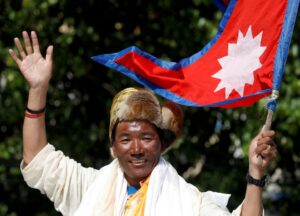It’s not what it used to be.
When I was a kid, Everest had been climbed only twice, by the British in 1953* and the Swiss in 1956, soon to be followed by an American team in 1963 (they were actually fourth, but a Chinese claimed ascent in 1960, now recognized, wasn’t immediately verified as authentic.)
I practically memorized Hillary’s description of the final moments of the first ascent:
“The ridge ciotinued as before. Giant cornices on the right, steep rock slopes on the left. I went on cutting steps on the narrow strip of snow. The ridge curved away to the right and we had no idea where the top was. As I cut around the back of one hump, another higher one would swing into view. Time was passing and the ridge seemed never-ending. In one place where the angle of the ridge had eased off, I tried cramponing without cutting steps, hoping this would save time, but I quickly realized that our margin of safety on these steep slopes at this altitude was too small, so I went on step cutting. I was beginning to tire a little now. I had been cutting steps continuously for two hours, and Tenzing, too, was moving very slowly. As I chipped steps around still another corner, I wondered rather dully just how long we could keep it up. Our original zest had now quite gone and it was turning more into a grim struggle. I then realized that the ridge ahead, instead of still monotonously rising, now dropped sharply away, and far below I could see the North Col and the Rongbuk Glacier. I looked upward to see a narrow snow ridge running up to a snowy summit. A few more whacks of the ice axe in the firm snow and we stood on top. My initial feelings were of relief — relief that there were no more steps to cut — no more ridges to traverse and no more humps to tantalize us. I looked at Tenzing and in spite of the balaclava, goggles, and oxygen mask all encrusted with long icicles that concealed his face, there was no disguising his infectious grin of pure delight as he looked all around him. We shook hands and then Tenzing threw his arm around my shoulders and we thumped each other on the back until we were almost breathless. The ridge had taken us two and a half hours, but it seemed like a lifetime.”
(Quoted from The Conquest of Everest, Hunt, John; E. P. Dutton & Co., New York: 1954, p. 205.)
That was then; today, Everest is a tourist attraction, and professional guides taking paying customers up fixed ropes to the top is a thriving business — although it’s still arduous, still dangerous, success is not assured, and people sometimes die up there.
One of those guides is Kami Rita Sherpa, 52, a Nepali who summited Everest for the 26th time on Saturday, May 7, 2022 (photo below; see story here). Reuters says Everest has been climbed 10,657 times since 1953 and 311 people have died attempting it. Most of these ascents have been from the south (Nepal) side, using the 1953 route. The 1960 Chinese team climbed it from the north, via the route of the British attempts before World War 2 (when Nepal was closed to foreigners). At least three other, much less used, routes have been completed.
As for me, I am and always have been just an armchair fan of Everest adventure stories, although I’ve had the privilege of meeting people who’ve done it, including Hillary and the first American, Jim Whittaker.
* I now have it on good authority, although not from the man himself, that Hillary took a leak on the summit. Tea will do that to you.
Photo: Kami Rita Sherpa, 52, has climbed Everest more times than anyone else
